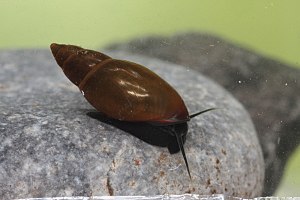Moss bubble snail
| Moss bubble snail | ||||||||||||
|---|---|---|---|---|---|---|---|---|---|---|---|---|

Moss bubble snail |
||||||||||||
| Systematics | ||||||||||||
|
||||||||||||
| Scientific name | ||||||||||||
| Aplexa hypnorum | ||||||||||||
| ( Linnaeus , 1758) |
The moss bladder snail ( Aplexa hypnorum ) is an air-breathing freshwater snail from the family of the bladder snail (Physidae), which is placed within the lung snail (Pulmonata) to the subordination of the water lung snail (Basommatophora) .
features
The left-handed case is relatively slim. The skin is thin and yellowish to reddish brown. The 6 threads are significantly higher than the opening and the turns are hardly arched, the opening is not inflated. It measures up to 15 mm in height and 6 mm in width. The mantle had no mantle extensions like the genus Physa . The antennae are thin, the foot and coat of the animal are black.
Multiplication
The moss bubble snail is only one year old. The young hibernate and begin to grow in spring from temperatures of 7 °. The eggs will be laid from May / June. The gelatinous egg capsules contain 5 to 31 eggs.
Way of life and distribution
The animals live in plant-rich ditches and ponds, but also in moors. They also tolerate relatively acidic water. The diet consists of debris and decaying plants. They occasionally leave the water by crawling up stems. It can even survive the drying up of the water.
Danger
The species is classified as endangered in Germany, Austria, Switzerland and Poland.
literature
- Peter Glöer: The animal world of Germany. Mollusca I Freshwater gastropods of Northern and Central Europe Key to identification, way of life, distribution. 2. rework. Ed., 327 D., ConchBooks, Hackenheim 2002 ISBN 3-925919-60-0